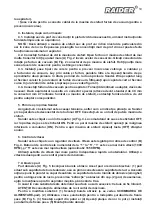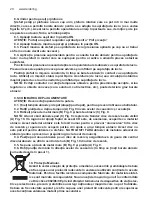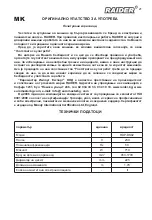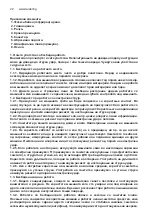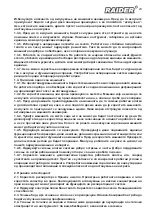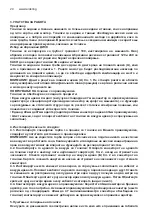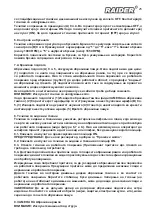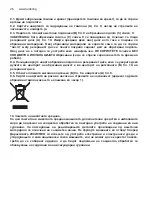
13
1.4.4. Store idle power tools out of the reach of children and do not allow persons unfamiliar
with the power tool or these instructions to operate the power tool. Power tools are dangerous
in the hands of untrained users.
1.4.5. Maintain power tools. Check for misalignment or binding of moving parts, breakage
of parts and any other condition that may affect the power tool’s operation. If damaged, have
the power tool repaired before use. Many accidents are caused by poorly maintained power
tools.
1.4.6. Keep cutting tools sharp and clean. Properly maintained cutting tools with sharp
cutting edges are less likely to bind and are easier to control.
1.4.7. Use the power tool, accessories and tool bits etc. in accordance with these
instructions, taking into account the working conditions and the work to be performed. Use
of the power tool for operations different from those intended could result in a hazardous
situation.
2. SAFETY RULES FOR DRYWALL SANDER
2.1. USE A RESPIRATOR approved by NIOSH for “Dust and Mist”. Ventilate work area and/
or use a dust collector. Continued and prolonged exposure to high concentrations of airborne
dust may affect the respiratory system function.
2.2. MAINTAIN FIRM FOOTING AND BALANCE. Use appropriate scaffolding. Do not
overreach.
2.3. SANDING OF LEAD-BASED PAINT IS NOT RECOMMENDED. Lead-based paint should
only be removed by a professional.
2.4. SANDING DRYWALL COULD LEAD TO A BUILD-UP OF STATIC ELECTRICITY ON THE
TOOL. For your safety, the drywall sander is grounded.
3. OPERATING INSTRUCTIONS
FOREWORD
The Drywall Sander is designed for sanding walls and ceilings that are made of drywall
or plaster. The Sander provides a superior finish, and is faster than conventional finishing
methods for both new construction and renovation work. Clean-up time is minimized by the
use of an external Vacuum Cleaner attached to the Sander.
ABRASIVE DISC SELECTION
The Drywall Sander is shipped with a 100 grit, abrasive disc installed. This abrasive is
suitable for most applications. Abrasive discs of 120 grit and 240 grit are available for
situations requiring a smoother finish.
HOW TO HOLD A DRYWALL SANDER
The Drywall Sander should be held with both hands on the main tube (A) as shown in Fig. 1.
The hands may be positioned anywhere along the main tube to provide the best combination
of reach and leverage for the particular application.
CAUTION: Keep hands on Main Tube (A) Fig. 1. Do not place hand into area around the
sanding head. The sanding head swivels in multiple directions and could pinch hand.
CONNECT DRYWALL SANDER TO VACUUM CLEANER
The following items are furnished with the Drywall Sander:
• One vacuum hose: 4m long (includes a standard 47mm vacuum cleaner connector on
one end and a special swivel connector on the Sander end), with a static dissipating feature
to dissipate static electrical charges that are sometimes experienced when recovering drywall
dust.
• One 40mm to 47mm adapter (adapts the 40mm hose connector to fit a 47 mm vacuum
cleaner).
• Six straps to connect the Sander cord to the vacuum hose (to prevent tangling).
4. INSTALL AS FOLLOWS:
4.1. Install a special drywall dust bag into your vacuum cleaner, following the instructions
Summary of Contents for RDP-DS02
Page 3: ...3 ...
Page 4: ...4 www raider bg ...
Page 48: ...48 www raider bg Exploded drawing of Drywall Sander RDP DS02 ...
Page 49: ...49 Spare Parts List of Drywall Sander RDP DS02 ...
Page 60: ...60 www raider bg ...
Page 65: ...65 ...
Page 67: ...67 ...



















